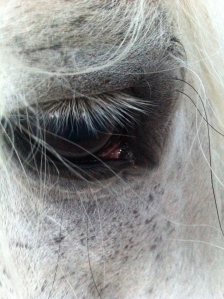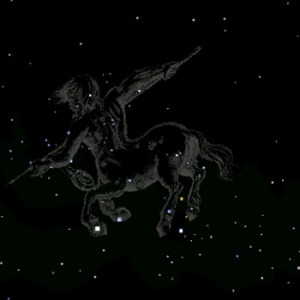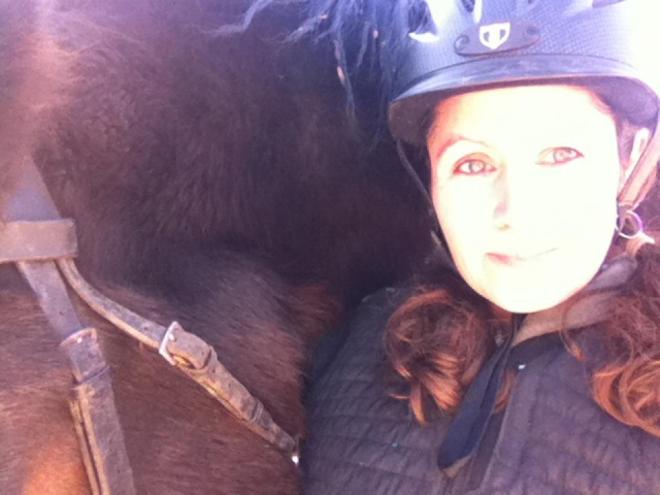 When I decided to purchase my mustang stallion, Tarot, I knew I had a long road in front of me. He had been in one home for each year he was captive. That made for six different homes before he finally made it to our farm. I knew he was what most people call a project and I wanted what he had to teach me. He was eleven years old and had yet to meet a human who could teach him what they wanted him to learn.
When I decided to purchase my mustang stallion, Tarot, I knew I had a long road in front of me. He had been in one home for each year he was captive. That made for six different homes before he finally made it to our farm. I knew he was what most people call a project and I wanted what he had to teach me. He was eleven years old and had yet to meet a human who could teach him what they wanted him to learn.
Things like walking up to be haltered, being fly sprayed in the summer, accepting a saddle without exploding and being led without bolting. But Tarot’s biggest issue from his past is allowing foot handling. He has a long history of kicking people that picked up his back feet but also of pulling away and being very uncomfortable with any of his feet being picked up, cleaned or trimmed. Most people just gave up and let them grow because he was dangerous or unpredictable when his feet were handled. It was uncomfortable for everyone. One of his past homes had a trainer out to help him learn to be handled but he took the “cooperate or run” approach. If Tarot kicked he made him run. Eventually Tarot would give in out of sheer exhaustion and they would get a few feet done, not always all four on the same day. It worked as a method outwardly, he did surrender his foot, but Tarot never learned to be more open to having his feet handled. Instead he learned when a human reaches for your hoof they are likely to turn unpredictable, demanding and obsessive. Hoof care for Tarot is deeply poisoned. It’s also our winter project.
It is infinitely easier to teach a behavior correctly from the beginning than to teach a new response in place of an undesirable one. Once a neural pathway has been mapped it can’t be erased. You can only build a new one and help the learner choose it over and over and over until that pathway becomes the habit. It sounds kind of simple but in practice it’s not so easy. That’s why I love my untouched mustangs so much, they are blank slates waiting for good information. Tarot has already been “programmed”, so to speak, and it is up to me to avoid the expression of those old responses while teaching something new. Learning can be bound up in a tactile sensation, which is unfortunate, because picking up feet can’t happen without some touch at least once you get down to cleaning out feet or actually trimming them. So how to approach the subject with him?
One of my favorite writers, Jeanette Winterson, writes, “Jung argued that a conflict can never be resolved on the level at which it arises – at that level there is only a winner and loser, not a reconciliation. The conflict must be got above – like seeing a storm from higher ground.”
I started out by teaching Tarot to target his knee to the end of a whip. Whips are something he isn’t afraid of – I guess there aren’t a lot of cowboys with whips – and more importantly, whips aren’t hands. I wanted to teach him to pick up his own foot and hold it up with a verbal cue. I wanted to split out the layers for him and just start with the subject, “Can you pick up your foot with a human near you?” instead of, “can you pick up your foot and surrender control of it to me?” Staying outside the depth of the conflict and above the storm. Here’s a video of where we are starting from today:
I have already faded the whip to just a finger point, mostly because I am incredibly clumsy walking with it by my side in the slippery snow. So my cue for the foot lift is to say the word “foot”, switch my lead to my left hand and point to his knee. When he raises his foot I drop my hand and I click when he seems relaxed. I’m not working on teaching him to pick up his feet, he knows how to do that now. I’m working on building relaxation like bedrock into the skill. The foot lift is the motion but the relaxation within it is the goal.
How do you speak to a horse about relaxation? You need both a clear training language and good listening skills. Tarot has to have the freedom to refuse my requests and the safety to express his conflict or anger without punishment. I have to know how to stay safe and non-reactive myself when he is upset. I need to be able to read small expressions of conflict/tension so I can see how well he is handling the work and make adjustments accordingly. I also need not just a “yes” answer (the click), but a “that was spectacular” answer so he can more easily understand the work. Right now, any foot offer without any tail swish or head raise is clickable. But sometimes he kicks his foot backs when he goes to set it down because he is tense and frustrated. I have already clicked so I am going to feed him because I don’t want to seem unreliable. But, when he softly offers his foot and lowers his head and sets it down softly he gets a click and treat and a chance to do a few nose targets. The nose targets are an easy behavior where he is sure to earn reinforcers and they offer the functional reward of a break from focusing on his feet.
Here’s a video of his right side where he is significantly less comfortable:
Here you see he is unable to lift his foot without extreme tail swishing/tail wringing. This tail movement shows how conflicted he is about me being on his right side and asking for his feet. He also leans his head and neck off to the left which is another conflict behavior he offers when he is uncomfortable and thinking about leaving. In it’s extreme form Tarot would spin away and present his hindquarters to me in a kick threat. He also is hurriedly offering me feet over and over even though I haven’t even said the cue or changed my lead rope to my inside hand. I’ve found with my mustangs when they are still nervous about their feet they offer them quickly and often instead of waiting to be cued. I’m not going to fuss about stimulus control when I am working on relaxation. So what to do? My rule of thumb is if he can’t offer a quiet response I will feed him for any foot lifting response despite the conflict he is showing. If he can eat he will begin to relax. So even though he is full of angst I feed him for each and every time his foot is in the air regardless of his emotional state. I do make a few mistakes because I was surprised at the level of conflict he displayed and had to change my plan on the spot. I should have just reached in my pouch and began feeding him immediately, sans click, the moment his foot left the ground. This is called counter-conditioning. Once he is able to offer a more relaxed response, then I will click that response and ask him to target as a reward. That response will become my new criteria. He raises the bar on his own at his own pace. By the seventh(!) repetition he offers a relaxed foot lift with no tail swish. I click, reward him with an opportunity to target my hand, and go back to his left side to give him the ultimate functional reward of leaving his right side.
You can’t force relaxation, you have to draw it out like a shy animal. You create the conditions for it to exist.


